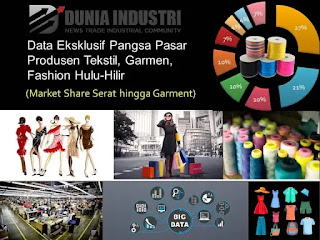Market Share Fiber Industry to Garment and Fashion in Indonesia
Exclusive Data on the Market Share of Textile, Garment, Fashion Producers (Fiber to Garment Market Share) released the fourth week of September 2020 featuring independent research, specific data research, comprehensive data, a map of the market share of the largest textile, garment and fashion producers. This research data contains 26 pages of pdf size 3.51 MB which is made to be a comprehensive guide and reference for investors, corporations, researchers, and various stakeholders at large.
This data research begins by presenting a brief review (highlights) of the national economy which was affected by two major events in 2019, namely the trade war in developed countries and in 2020, namely the Covid-19 pandemic. A brief review of the dynamics of the Indonesian economy is described in detail on page 2 to page 4. Despite the challenges, there are still opportunities, especially by looking at the global development megatrends, especially in relation to digitization, until 2045. Then move on to the demographic mapping of the Indonesian population, starting from population projections. population in Indonesia in 2045, life expectancy, composition of the population in urban and rural areas. The number of productive age population in Indonesia is the largest in Asean. (pages 5 to 8) On the other hand, the number and density of population in Indonesia by region is also shown. As well as the contribution of the economy per region to Indonesia’s total gross domestic product, with the largest portion still being held by Java.
Followed by the projection of Indonesia’s economic growth for 2016 to 2045 with two scenarios (basic scenario and high scenario). (page 9) Also, indicators of economic growth in 2045 and the stages towards a modern economy. (page 10)
Entering the focus of data research, Exclusive Data on Market Share of Textile, Garment, Fashion Producers (Fiber to Garment Market Share) examines the market share map of the largest textile, garment and fashion companies for the period 2019-2020. The discussion on market share is divided into 6 main categories, namely textile fibers, yarns, spinning, weaving, finishing, and garment.
Market share discussions are carried out based on the real production capacity of each company, displayed with a pie chart graphic and a bar table to facilitate understanding. On page 12 to page 15, a map of the market share of the largest textile fiber producers is displayed. Of the 20 major textile fiber players in Indonesia, the discussion on market share is focused on the 11 largest companies. The market share data is also complemented by the respective production capacities of the top 10 market leaders.
Meanwhile the market share map of the largest yarn companies is displayed on page 16 and page 17, equipped with the capacities of each of the top 10 market leaders. Likewise, the market share map for the largest spinning companies is displayed on pages 18 and 19, containing the top 4 market leaders along with real production capacity.
A map of the largest weaving companies’ market share is displayed on pages 20 and 21, containing the top 4 market leaders along with their real production capacity. Meanwhile, the market share map of the largest finishing companies is shown on pages 22 and 23, containing the top 4 market leaders along with their real production capacity. Finally, a map of the company’s market share for the spread of garment is displayed on pages 24 and 25, containing the top 4 market leaders along with their real production capacity.
Exclusive Data on the Market Share of Textile, Garment, and Fashion Producers (Fiber to Garment Market Share) consists of 26 pdf pages measuring 3.51 MB which are easy to download with easy digital download technology. This specific data comes from big data research duniaindustri.com, supported by supporting data from BPS, the Ministry of Industry, the Indonesian Textile Association (API), Apsyfi, and market leader companies. Industry data index is the latest feature on duniaindustri.com which displays dozens of selected data according to the needs of users. All data is presented in pdf format so that it is easy to download after users proceed according to the procedure, namely click buy (purchase), click checkout, and fill out the form. Duniaindustri.com prioritizes the validity and validity of the data sources presented. Thank you for your trust in duniaindustri.com. (*)
Source: click here



Komentar
Posting Komentar